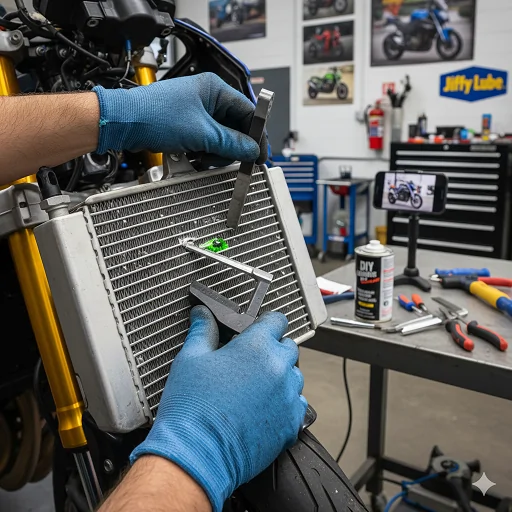Motorcycle Radiator Repair: Costs, Leaks, and Prevention
A motorcycle’s engine is a masterpiece of engineering, **yet** its greatest enemy remains heat. **Therefore**, the **motorcycle radiator** is a critical component for engine survival. When you notice signs like a steadily rising temperature gauge or a sweet smell of coolant, you face a common problem: radiator damage. **Consequently**, knowing how to approach **motorcycle radiator repair** is essential for every rider. Neglecting a leaky or damaged radiator leads quickly to engine overheating, **ultimately** resulting in catastrophic and expensive failure.
In this comprehensive guide, **first**, we will explain how to diagnose common radiator issues, **such as** bent fins and minor leaks. **Next**, we will provide a step-by-step **HowTo** for DIY fixes and temporary repairs. **Furthermore**, we will cover when to opt for professional service or a complete replacement. **Indeed**, mastering the basics of **motorcycle radiator repair** will save you money, protect your engine, and keep you confidently on the road.
1. Diagnosing Damage: Is Your Motorcycle Radiator Leaking?
The first step in any **motorcycle radiator repair** is accurate diagnosis. **Typically**, damage falls into two categories: external damage (bent fins) and internal damage (leaks or clogs). **Therefore**, you must inspect the unit thoroughly.
- **Minor Leaks (Pinhole):** **Often**, small holes are caused by road debris flicking up. **Usually**, coolant loss is slow, and you might only see residue around the source.
- **Bent Fins:** These thin metal pieces regulate heat transfer. **However**, bent fins reduce cooling efficiency, **potentially** leading to higher engine temperatures.
- **Major Cracks/Holes:** **Clearly**, these result in rapid coolant loss and require immediate attention, often professional repair or replacement.
**To check for leaks**, allow the engine to cool completely. **Then**, remove the radiator cap and check the coolant level. **Crucially**, if the level is low, look for visible streams or dried residue. **For example**, a professional pressure test can pinpoint invisible leaks quickly.
2. DIY Motorcycle Radiator Repair: Quick Fixes You Can Do Now
**Fortunately**, not all radiator issues require a trip to the repair shop. Minor damage can **often** be handled right in your garage. **Therefore**, here is how to tackle the two most common DIY **motorcycle radiator repair** tasks:
How to Fix Bent Radiator Fins
Bent fins are a common sight, **especially** on off-road bikes. **Since** they block airflow, straightening them is vital for cooling performance. **Consequently**, you need to work slowly and gently:
- Use a specialty **radiator fin comb** tool.
- **Alternatively**, use a small, thin screwdriver or a pocket knife blade.
- Slide the tool between the fins. **Gently**, bend the damaged metal back into place.
- **Remember**, straightening fins does not involve the coolant system itself, **thus** it is a purely external repair.
How to Patch a Pinhole Leak (Temporary Fix)
For small, pinhole leaks, a temporary patch can get you home safely. **However**, this is not a permanent solution! **Indeed**, always seek a professional repair after using a temporary sealant.
- **Drain and Clean:** **First**, partially drain the coolant below the leak level. **Next**, clean the area thoroughly with degreaser and sandpaper.
- **Apply Epoxy/Sealant:** Use a high-temperature, metal-specific epoxy or chemical sealant (like JB Weld).
- **Cure Time:** **Crucially**, allow the sealant to cure completely as directed by the product instructions before refilling the coolant.
**For instance**, the short video below provides a quick visual example of simple coolant maintenance.
Watch: Motorcycle Coolant Check (YouTube Short)
3. When to Choose Professional Repair vs. Replacement
Deciding between repair, recore, or full replacement depends on the severity and location of the damage. **Generally**, here are the considerations for your **motorcycle radiator repair** options:
| Damage Type | Recommended Action | Reasoning |
|---|---|---|
| Minor Leak (1-2 pinholes) | Professional Soldering or Welding | A shop can permanently solder aluminum or brass without sacrificing cooling capacity. |
| Extensive Fin/Tube Damage | Radiator Re-core | If the side tanks are fine, replacing only the core is cheaper than a new unit. |
| Cracked End Tank / Severe Corrosion | Full Replacement | Tank cracking compromises structural integrity, **therefore** full replacement is the safest option. |
**Furthermore**, consider the age and value of your motorcycle. **For instance**, replacing a rare vintage radiator might require specialized aluminum welding services, **while** a common model might be cheaper to simply replace with a new OEM or aftermarket unit. **Thus**, always obtain a repair quote before deciding.
4. Protecting Your Radiator: Prevention is the Best Repair
The best **motorcycle radiator repair** is the one you never have to do! **Consequently**, adopting preventative measures is key to maximizing the lifespan of your cooling system. **Since** most damage comes from external debris, corrosion, or neglected maintenance, these simple steps make a huge difference:
- **Install a Radiator Guard:** This mesh cover deflects stones and large debris without significantly impeding airflow.
- **Regular Coolant Flushes:** Over time, old coolant loses its anticorrosive properties. **Therefore**, regularly flushing the system prevents internal corrosion and clogs. This is similar to routine car maintenance: Ford Radiator Flush Procedures and Tips.
- **Check Hoses and Clamps:** **In addition**, ensure all hoses are pliable and clamps are tight. **Ultimately**, small leaks from weak connections lead to serious issues.
This proactive approach significantly reduces the chance you will need emergency **motorcycle radiator repair** down the line.
Further Reading and References
To deepen your understanding of the cooling system and its maintenance, explore these resources:
- **Wikipedia Reference (Engine Cooling):** Learn more about the basic function and components of a vehicle’s Engine Cooling System.
- **Specific Flush Guide (External Link):** For more specialized advice, see this guide on Ford Radiator Flush Procedures and Tips.
Frequently Asked Questions (FAQ)

